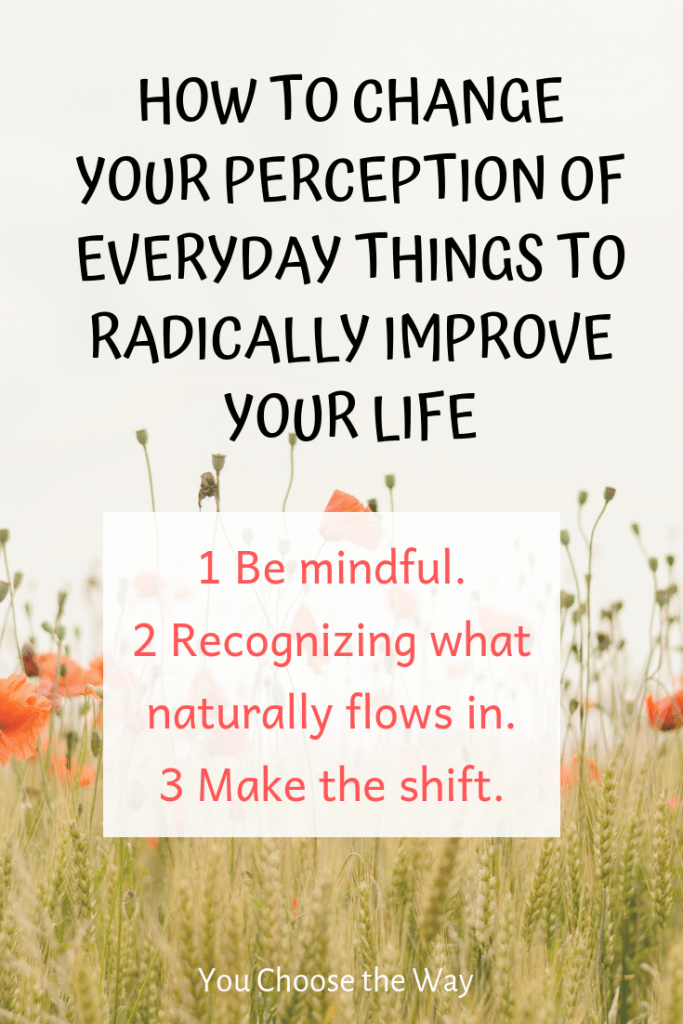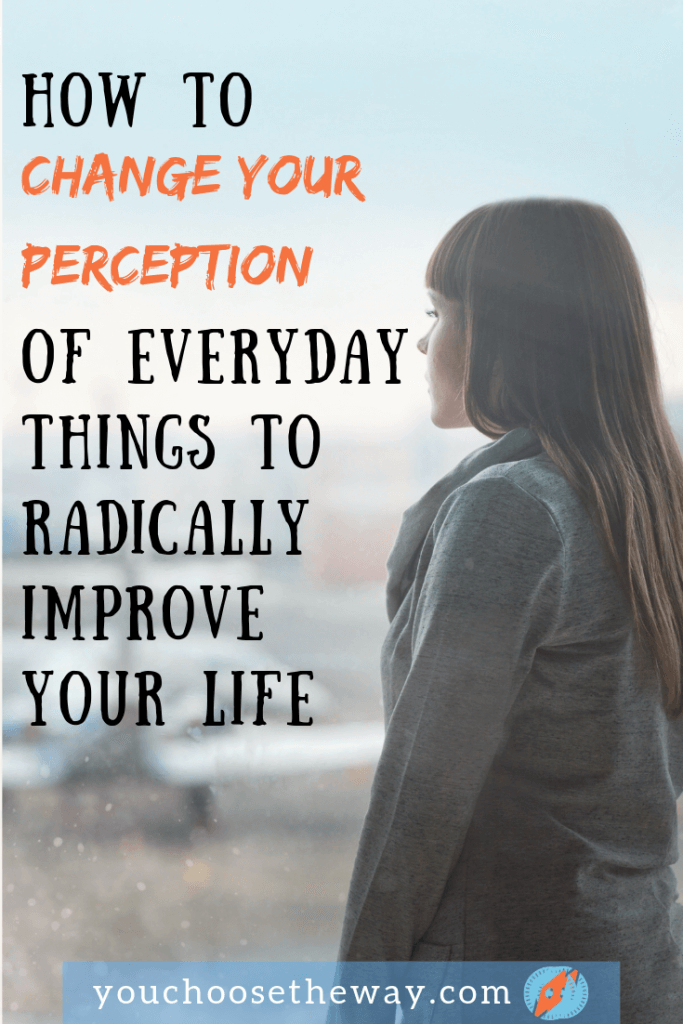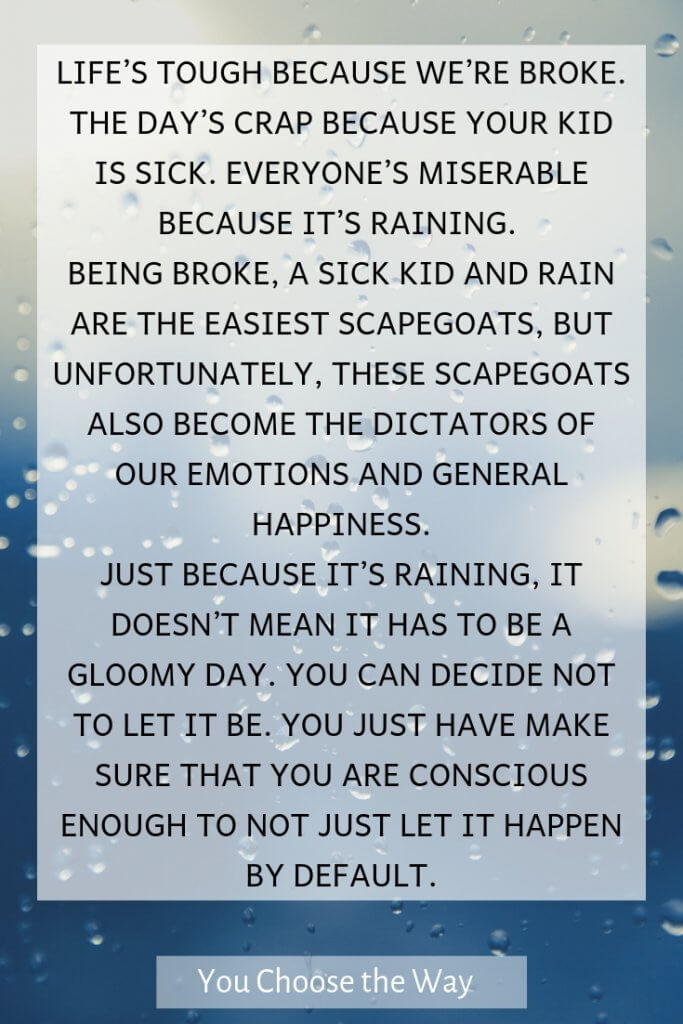Your perception is your reality. If you think life sucks, then it probably will. It doesn’t matter what your external circumstances are because internally, you’ve decided to see the world from behind dark glasses. But if you do nothing more than change your perception, it changes the whole story. Suddenly you smell the blooming flowers, hear the laughing kids and feel the warmth of the sunshine on your face.

Finding a different viewpoint changes the way everything looks. It’s like when you randomly sit at a different desk at work. It’s the same office, the same muffled chatter, the same disinfectant smell, yet it feels like a whole new world.
This small variation might make you act differently, treat people differently, feel differently inside or cause you to explode into an allergic reaction due to some new cubicle neighbor’s horrid perfume.
How an optimistic perception kept me walking
I may be a bit biased about perceptions. As a kid, it was thanks to my parent’s ability to see possibilities while confronting an “unsolvable issue” that I was didn’t end up living my whole life in a wheelchair.
Let me rewind.
At 6 years old, I stopped being able to walk properly. Throughout the days, my legs just seemed to lose their strength. By the end of most days, I was immobile.
My folks brought me to a bunch of different doctors, but no one had any clue of what was wrong with me. After almost a year of appointments, specialists and tests, the outcome with grim.
My parents were told I wouldn’t ever walk. It was time that they accept the reality of my situation and start looking for wheelchairs.
It would have been easy to see this situation as hopeless.
They easily could’ve taken the doctors’ words to heart, and given up.
But they didn’t. They persevered, fought against the imposed verdict and found a solution.
They decided that no wasn’t going to be an acceptable answer. They kept their focus on finding a solution no matter how unlikely it seemed. Eventually, they found a new doctor. He knew what was up as soon as he saw me. I started taking pills the next day and the rest is history.
I don’t tell you this sad tale is hopes of throwing a pity party. On the contrary, this story shines bright as a bold example of how your perception is your reality.
My parents chose to keep seeing this situation as solvable, so it was solved.
How easy might it have been to accept the diagnosis and move on with life this way?
Super easy. And the only difference is how they saw the situation.
The perceived value of gym class
If you’ve never been ill, it be can easy to take your body and your health for granted.
But as a young kid that had just escaped a life of limited mobility, I was ecstatic about my freedom to roam. I was excited to walk, to run, to dance and felt like I could fly.
(There lies the source of my antsy feet.)
All the while other kids complained about having to do gym class.

Gym class is the exact same thing for one kid as it is for another. We each get the same instructions, have to do the same activities and deal with the same teachers. It’s the way we each viewed gym class that made it either your favorite class of the week or the most dreaded moment of your life.
It’s not a fact. It’s not a debatable concept. We just each get to choose how we see it.
The power of getting to choose your perception
The crazy thing is how many of us forget how much power lies in our hands, how responsible we each our for the context we create for ourselves.
Instead, many of us just accept things as they are, and blame whatever external thing is easiest to blame.
Life’s tough because we’re broke. The day’s crap because your kid is sick. Everyone’s miserable because it’s raining. Being broke, a sick kid and rain seem to be the easiest scapegoats. But the unfortunate thing is that these scapegoats also become the dictators of our emotions and general happiness.
We give away our power to find beauty and be happy to excuses we encounter along the way. And sure, we don’t do it on purpose, we do it because we forget the power we have to change our perception.
Just because it’s raining, it doesn’t mean it has to be a gloomy day. You can decide not to let it be.
You just have make sure that you are conscious enough to not just let it happen by default.
How to change your perception
I’ve taken the liberty of writing out a short 3 step process to help you change your perception. But be warned, although the instructions might be short, I can assure you that learning to implement this strategy might take a bit of dedication and faith.
I know, you might be skeptical about whether this will even make you ________ (fill in the blank with the desired emotional state you’re looking to achieve), which is why you’ll need faith. But it’ll only be required for a short time, cause I have no doubt that slowly you’ll start recognizing the drastic changes in your life due to your new vantage point.
Step 1: Mindfulness

By default, most of us spend our time agonizing about the past or daydreaming about the future. We don’t live in the present. And because of that, we aren’t conscious of most of our thoughts, feelings, activities or interactions.
The best strategy I know to bring more awareness into our inner and outer circumstances is through mindfulness. If you’re not too sure what mindfulness is, check out this article about alternatives of meditation.
Basically, it’s all about being more present with the now and accepting what you find.
By being mindful throughout your days, you naturally notice the way you are looking at the world and so get the opportunities to gently shift your perception when it’s not serving you.
Step 2: Recognizing what naturally flows in
Better understanding your general thoughts, feelings, complaints, inner critics, discussion topics, reactions and other day-to-day ways of being you notice what might need tweaking.
Maybe you naturally worry a lot or are an excessive planner who just obsessively plans out every step of your day 5 minutes before doing anything.

Ask yourself whether these ways of being or ways of looking at things actually benefit you. Whatever’s not working for you can then be adjusted.
For example, let’s say that after taking some time to see what naturally flows in, you realize that you spend a lot of time thinking about how much you’d like to meet someone with whom to share your life.
Then, once you start paying even closer attention to how you talk about doing this (with yourself or others), you notice that you’re usually pretty pessimistic about the whole thing.
You catch yourself telling people that you’ll never meet a man who can keep up with you, and that everyone you go on dates with are horrible and that it’s basically hopeless.
Well, my friend, if that’s how you are approaching this whole situation I can see why you aren’t having any luck. I assume you’re bringing this unpleasant dating mindset with you on dates. Then, like it or not, that vibe can be felt. It’s palpable. Even the couple at the next table can see that you’re arriving with doubts, skepticism and arrogance lingering over your shoulder.
To dive into an even more common example, take a minute to ponder about how you feel about your workday. What viewpoint do you arrive
If either one of these are you, then take a minute and just think about it. How is having these thoughts all the time benefiting you?
I assume the answer is “not at all”. But I also assume that you’re skeptical about whether there’s anything you can actually do to change those thoughts.
I assure you, there is.
Step 3: Make the shift
We’ve taken the time to be more present, become acquainted with our general ways of being, and even questioned whether they’re actually improving our lives in some way.
If your conclusion is that they don’t, this is where the change gets implemented.
Making the shift means consciously finding beauty, hope, kindness or whatever other more beneficial aspect you’d like the uncover from your current context. It means shifting your focus from one of blame and excuses, to one of responsibility and taking charge.
No, it’s not that all the men in the world suck and you’ll never meet the right one for you, but that’s the way you’re looking at the situation. Ask yourself whether there could possibly be another viewpoint.
Maybe you go to dates with a bad attitude, choose jerks to go out with, or maybe there’s plenty of kind and worthy guys in your life, but you just aren’t focusing on them. Instead you’re focusing your attention on the few bad apples that have appeared in your Tinder lately.
Sometimes, it’s not because you need to change jobs, try to get a promotion or go through the effort and hassle of doing a massive career shift. But instead, you need to just look at your professional reality in a new light.
If you stay there because you love your coworkers and it gives you the schedule flexibility of your dreams, then great! Focus on that. Have that be what dominates your ideas about work. Not the other negative stuff.
Basically, in this step, you’re taking the time to see what other possible ways there are to look at this situation. Imagine it as though you’re in the mountains trying to take a killer photo of some mountain goat that’s appeared. From where you are now, the essence of the goat isn’t being captured. But what if you move to its right, or if you moved behind it from where you’d only see its shadow. Or maybe you need to go higher up on the mountain to look down on it. To be able to find to best possible shot of the goat, you might have to wander around and check out the different ways to see it.

Do the same with your life or whatever aspect of your life that’s not going as amazingly as you’d like. Once you’ve chosen how you’d prefer to look at the situation, go back to that way of thinking every time you notice yourself indulging in the repetitive negative thoughts you’ve always had about this context.
You might have to do nudge your mind back to the positive idea 50 times before it start happening more naturally. That’s because your mind has created a habit of automatically going to the negative thoughts.
All you need to do is reprogram your mind to automatically go towards the more beneficial thoughts.
Closing thoughts
How often does it happen that you go to the movies or visit some tourist attraction with a friend and you both walk out with completely different opinions about how that was?
This happens to me all the time.
And I’m not suggesting that you make an effort to shift your view point about some insignificant movie. But this common situation is a good reminder that there are always a million different ways to look at a situation.
Are you regularly checking in with yourself to make sure that your view points are serving you?
If not, might I suggest that you start?
You might be surprised by how radically your life can change by just changing the way you look a situation. Who knows, an improved viewpoint might be what cures your child

Would like to read about how to change your perception, but don’t have time right now? Pin it here.






As brave as a Canadian tree.
You are amazing! I read a lot about mindset, mind, thoughts, and…, from many autors its a part of my job.
But your notes was great, simple but deep to changing perception! Good luck
Aw, that is very kind of you to say. I hope to restart writing here again soon. I’ve been on a bit of a blogging hiatus, since writing my book.